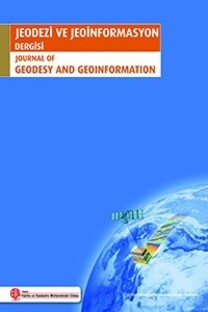VLBI Ölçümlerinden elde edilen VieVS ve Solve UT1 Sonuçlarının Karşılaştırılması
VLBI, IVS, UT1, Yer dönüklüğü
Comparison of VieVS and Solve UT1 results from VLBI measurements
VLBI, IVS, UT1, Earth rotation,
___
- Agnew D.C., (1997), NLOADF: A program for computing ocean- tide loading, J. of Geophys. Res, vol. 102, pp. 5109–5110, doi: 10.1029/96JB03458
- Agnew D.C., (1996), SPOTL: Some programs for ocean-tide load- ing, SIO Ref. Ser., 96-9, Scripps Institute of Oceanography, La Jolla, 35p.
- Bolotin S., (2000), SteelBreeze home page,http://steelbreeze.sourceforge.net. Accessed on 20 March 2015.
- Böhm J., Böhm S., Nilsson T., Pany A., Plank L., Spicakova H., Teke K., Schuh H., (2009), The New Vienna VLBI Software VieVS, In: Proceedings IAG Scientific Assembly 2009, In: Inter- national Association of Geodesy Symposia Series Vol. 136, pp 1007-1011.
- Böhm J. and Schuh H., (2007), Forecasting Data of the Tropo- sphere Used for IVS Intensive Sessions, In: Proceedings 18th European VLBI for Geodesy and Astrometry Working Meeting, 12-13 April 2007, Vienna, pp 153-157.
- Böhm J., Werl B., Schuh H. (2006), Troposphere Mapping Func- tions for GPS and Very Long Baseline Interferometry from Euro- pean Centre for Medium-Range Weather Forecasts Operational Analysis Data, Journal of Geophysical Research, 111, B02406, doi: 10.1029/2005JB003629.
- Böhm J., Niell A., Tregoning P., Schuh H., (2006), Global Mapping Function (GMF): A New Empirical Mapping Function Based on Numerical Weather Model Data, Geophysical Research Letters 33, L07304, doi: 10.1029/2005GL025546.
- Dickman S.R., (1993), Dynamics ocean-tide effects on Earth's ro- tation, Geophysical Journal International, 11, pp 448-470, doi: 10.1111/j.1365-246X.1993.tb01180.x
- Engelhardt G., Thorandt V., Ullrich D., (2011), VLBI Analysis at BKG, In: Proceedings 20th European VLBI for Geodesy and As- trometry Working Meeting, 29-31 March 2011, Bonn, pp 102- 104.
- Gipson J., MacMillan D., Petrov L., (2008), Improved estimation in VLBI through better modeling and analysis, In: Proceedings5th International VLBI Service for geodesy and astrometry General Meeting 2008, pp 157-162.
- Hobiger T., Otsubo T., Sekido M., Gotoh T., Kubooka T. and Taki- guchi H., (2010), Fully Automated VLBI Analysis with c5++ for ultra-rapid determination of UT1, Earth Planets Space, 62, pp 933-937, doi: 10.5047/eps.2010.11.008
- Petit G. and Luzum B., (2010), IERS conventions 2010, (IERS Technical Note; 36) Frankfurt am Main: Verlag des Bundesamts für Kartographie und Geodësie, 2010. 179 pp., ISBN 3-89888- 989-6.
- Kantha L.H., Steward J.S. and Desai S.D. (1998) Long-period lu- nar fortnightly and monthly ocean tides, Journal of Geophysical Research, 103, 12, 639, doi: 10.1029/98jc00888.
- Ma C., Sauber J., Clark T., Gordon D., Himwich W.E., Ryan J.W., (1990), Measurement of horizontal motions in Alaska using very long baseline interferometry, Journal of Geophysical Research, 95, B13, 21991-22011, doi: 10.1029/JB095iB13p21991.
- MacMillan D., Behrend D., Kurihara S., (2012), Effects of the 2011 Tohoku earthquake on VLBI geodetic measurements, In: Proceed- ings 7th International VLBI Service for geodesy and astrometry 2012 General Meeting, pp 440-444, NASA/CP-2012-217504.
- Niell A.E., (1996), Global mapping functions for the atmosphere delay at radio wavelengths, Journal of Geophysical Research, 101, 32273246, doi: 10.1029/95JB03048.
- Petrov L. and Baver K.D., (2008), Description of the keywords of BATCH control language, 7/31/2008.
- Petrov L. and Boy J.-P., (2004), Study of the atmospheric pres- sure loading signal in very long baseline interferometry ob- servations, Journal of Geophysical Research, Vol. 109, B3. doi 10.1029/2003JB002500.
- Petrov L. and C. Ma, (2003), Study of harmonic site position vari- ations determined by very long baseline interferometry, J. Geo- phys. Res., 108, 2190, doi: 10.1029/2002JB001801.
- Plank L., Böhm J., Schuh H., (2010), Comparison campaign of VLBI data analysis Software - First Results, In: Proceedings 6th International VLBI Service for Geodesy and Astrometry 2010 General Meeting, pp 217-221, NASA/CP-2010-215864.
- Plank L., (2010), Results from the VLBI data analysis software comparison campaign, Presented at The First VieVS User Work- shop, in Vienna, Austria, 2010.
- Ray R.D., (1999), A global ocean tide model from TOPEX/POSEI- DON Altimetry: GOT99.2, NASA/TM-1999-209478, Greenbelt, 58 p., 1999.
- Saastamoinen J., (1972), Atmospheric correction for troposphere and stratosphere in radio ranging of satellites, The Use of Ar- tificial Satellites for Geodesy, Geophysics Monograph Series, Vol. 15. Edited by Soren W. Henriksen, Armando Mancini, and Bernard H. Chovitz. Washington, DC: American Geophysical Union, 1972., p.247.
- Saastamoinen J., (1973), Contributions to the theory of atmospher- ic refraction, Bulletin Godsique, Volume 47,Issue 1, pp.13-34, doi: 10.1007/bf02522083.
- Schuh H. and Behrend D. (2012), VLBI: A fascinating technique for geodesy and astrometry, Journal of Geodynamics, Vol. 61, pp. 6880. doi: 10.1016/j.jog.2012.07.007.
- Titov O., Tesmer V. and B ̈ohm J., (2004), OCCAM v. 6.0 Software for VLBI data analysis, Proceedings 3rd International VLBI Ser- vice for Geodesy and Astrometry 2004 General Meeting, pp 267- 271, NASA/CP-2004-212255.
- USNO Toshi web site http://toshi.nofs.navy.mil/ ser7/readme. Ac- cessed on 20 March 2015.
- Uunila M., Baver K., Gipson J., Nilsson T., (2012), Comparison of UT1 and polar motion from IVS sessions derived from VieVS and solve analysis, In: Proceedings 7th International VLBI Service for Geodesy and Astrometry General Meeting 2012, pp 400-404, NASA/CP-2012-217504.
- Wahr J.M. and Bergen Z., (1986), The effects of mantle anelastic- ity on nutations, Earth tides, and tidal variations in rotation rate, Geophysical Journal of Royal Astronomical Society, 87(2), pp 633-668, doi:10.1111/j.1365-246X.1986.tb06642.x.
- Yoder C.F., Williams J.G. and Parke M.E., (1981), Tidal variations of Earth rotation, Journal of Geophysical Research, 86(B2), pp 881-891, doi:10.1029/JB086iB02p00881.
- ISSN: 2147-1339
- Yayın Aralığı: Yılda 2 Sayı
- Başlangıç: 2012
- Yayıncı: TMMOB Harita ve Kadastro Mühendisleri Odası
VLBI Ölçümlerinden elde edilen VieVS ve Solve UT1 Sonuçlarının Karşılaştırılması
Minttu UUNİLA, Karen BAVER, John GİPSON, Tobias NİLSSON, Hana KRÁSNÁ, Ozan KILIÇ
Koordinat dönüşümünde EIV model klasik dengeleme yoluyla nasıl çözülür?
2014 Ege Denizi Depremi Öncesi GNSS İstasyonlarında Gözlemlenen TEC Anomalileri
